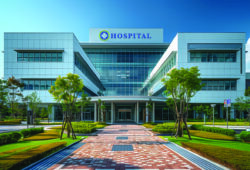Seeking creative solutions to disruptions & challenges
COVID-19 uncovered vulnerabilities and magnified existing problems in the supply chain across all industries. In this post-pandemic landscape, disruption continues—from extreme weather events and political unrest to ongoing shortages of raw materials and emerging viruses. Some healthcare providers are facing uncertainty and costly backorders lasting for months. Predictive analytics, artificial intelligence (AI) and other technological advances are more important than ever in mitigating the disruptions.
These disruptions are impacting all areas of healthcare supply. For example, the American Society of Health-System Pharmacists reports that ongoing and active drug shortages are now at their highest levels since 2014. At the same time, hospitals are exploring ways to improve operational efficiencies at all levels, including in the supply chain.

To face these challenges head on, it’s necessary to embrace change and work with new tools and methods. Disruption is now a consistent part of the healthcare industry, says Ramy Hanna, Region CEO, HCA Healthcare. “Supply chain disruptions and other complexities are here to stay. For hospitals to successfully navigate the challenges ahead, they need to consider ways to create broader value beyond pricing by looking at nontraditional and transformative approaches.”
Embracing new solutions
The old days of hospitals relying on traditional approaches to optimize their supply chain, such as using physician preference cards to decrease cost per case, are gone, explains Hanna. Now is the time to reassess what’s working—and what isn’t—and look for new solutions to today’s obstacles.
“The focus on solving immediate challenges brought on by COVID-19, labor shortages and supply disruption has caused many hospitals to overlook opportunities to create operational efficiencies,” notes Hanna. “It’s now forced many to rethink what needs to be done.”
Scenario planning is more critical than ever in supply chain management. Relying on old methods of managing the supply chain—such as going on allocation or using a back-up supplier—is no longer enough with the frequency of modern-day supply disruptions.
“We need to be more agile and anticipatory of disruption. Historically, if supplier A was out, we could go to supplier B. Now, A and B could both be out, and we may have to go to supplier C to make it work,” says Hanna.
By improving visibility into second- and third-tier suppliers, supply chain leaders gain confidence in the resilience of their supply chain operations and can develop cost-effective solutions. Hanna suggests hospitals identify their strategic partners and work closely to develop feasible contingency scenarios. Key suppliers, HealthTrust and clinicians are all possible partners.
To keep up with industry changes and potential solutions, he recommends hospital leaders engage in continuous learning by visiting other hospitals and integrated delivery networks, attending conferences and engaging with experts for fresh perspectives. “It’s easy for hospital leaders to become comfortable with how they are operating, but that may not be the most efficient,” he adds. “There is a real opportunity here for HealthTrust members to benefit from the collective wisdom found within our broad membership.”
Standardizing inventory and reducing variation in SKUs across hospitals is another opportunity to improve supply chain operations. This allows the supply chain to secure better prices through contract renegotiation, eliminating waste, optimizing storage space and simplifying training. Hanna also recommends hospitals think creatively about how to optimize inefficient operations in three main buckets: people, processes and technology.

Technological transformation
While hospitals and health systems have been implementing technological advances for years, the opportunities that exist now, or will soon exist, are full of possibility. AI, automation and robotics all have enormous potential to improve supply chain operations—improving caregiver job satisfaction and the patient experience while managing staffing constraints, enhancing service excellence, mitigating risk and reducing cost.
Investing in technology such as smart cabinetry can free up staffing resources and allow healthcare workers to focus on patient care. Automation can also be used to manage supplies more efficiently while freeing up staff.
HCA Healthcare leaders understand that staying on the cutting edge of technology helps them deliver the best care possible and have implemented a number of new technological tools. For example:
- Lumere captures new product requests from physicians, streamlining them by serving as a central repository for all HCA Healthcare product requests. It is also a resource to support evidence-based decisions and is available on any mobile device.
- OneRecall is the organization’s new source of truth for recalled items. Instead of receiving recall information by mail, staff members responsible for managing or ordering the item are notified directly by email or phone call. Notifications include all the information needed.
- Teletracking is a bed management system that uses Real-Time Location Systems to provide advanced visibility. It can identify bottlenecks in the patient flow process and provides quick identification to speed up resolutions and improve the patient experience.
- Computrition is a food service automation tool. It automates order-taking, production and menu planning and integrates with other tools to consider dietary restrictions and allergies for each patient order. Optional add-ons include Tray InMotion, a tray tracking and patient identification tool, and OnTray, a self-directed ordering application that patients can use on their personal devices.
Up-leveling traditional tools
“New” technologies also improve existing tools to impressive new levels, pushing the boundaries of what’s possible.
Take the traditional physician preference card, which lists a surgeon’s tools, supplies and room setup for a specific procedure. New products are added to cards without removing older products, leading to waste and overstocking.
Currently, tools on the market can give a retrospective look at six months to a year of data on any given case and by doctor and provide preference card maintenance recommendations. This ensures the necessary items and quantities are available for a procedure without overstocking, which saves money and simplifies the process for physicians and nurses.

But reviewing those recommendations is a manual process, and that’s where Ron Powell, CEO Supply Chain, National Group, HCA Healthcare, sees potential for value. “There is so much trust in the provider preference tool we use that the nursing organization has said, ‘If it meets these certain parameters, then make the change. You don’t need us to review it,’ ” he says. “If we could have the tool further developed, so that when those criteria are met, it updates the card, and no human has to touch it, that would enable the people involved to go do other higher-level, value-added services.”
Powell adds, “In the future, we need more AI-driven solutions that constantly look at our data in the background, review our spend and either automatically make adjustments or flag exceptions to an appropriate user or manager.”
Predicting the future with analytics
In the aftermath of COVID-19 and other disruptions, HCA Healthcare, like many other hospitals and health systems, is looking into ways to further predict and prepare for external events.
“We’re trying to get farther upstream and see what’s happening with our manufacturers, know what’s happening with raw materials, understand from where the next shortage may come and be able to make some predictions,” explains Powell. “This is taking us down paths of gathering new data and looking at it differently than we’ve ever looked at it before, so we can anticipate shortages that we didn’t see coming.”
COVID-19 demonstrated the vulnerabilities across all industries of relying on products only manufactured in certain areas of the world. Could AI, for example, be used to analyze global weather trends or political insecurity and predict when and how production might be impacted?
The full scope of predictive data analytics in the supply chain is just starting to be discovered. Powell sees potential for using AI and data analytics to better predict what supplies a hospital will need, for example, by identifying trends in disease growth and the products and supplies typically needed to treat that patient population. This data can help hospitals identify vulnerabilities in their supply chain, and, if manufacturers had access to this data, it could help them better meet anticipated demand—a win for both hospitals and manufacturers.
Using predictive analytics to improve existing tools is also being explored. For example, AI tools that manage staffing levels based on predicted patient volume have been in use at HCA Healthcare and other hospitals for a number of years. But imagine taking that tool further so that it could predict the acuity level of patients and match that to an appropriate level of staff. And then, another step further: to predict the type and quality of supplies staff will need to care for those patients.
“We’re not going to get there overnight, but these are the things that we’re talking about and many of our members are talking about. We need to be able to think that far ahead using data and the power of AI to drive this,” says Powell.
For more information on optimizing your operations and driving value back into the supply chain, contact your HealthTrust Account Manager or email thesource@healthtrustpg.com to start the conversation.
Share Email Innovation, Q4 2023




